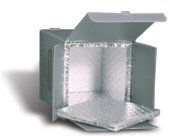
The technology behind vacuum insulation panels (VIP) has been around since the 1980s, but only in recent years has VIP been commercially viable. Continued improvements are expanding applications, making VIP an option as secondary packaging for food processors.
A recent breakthrough is the use of ultrathin metallized polyester laminates to enclose the panels. VIP fabricators have used foil laminates as an oxygen and moisture barrier, but that creates an "edge effect," with heat being transferred around the panel. The application of DuPont Mylar SBL 300 metallized film by Advantek Inc. of Minnetonka, Minn., solves that problem. It also garnered the top packaging award for technical achievement from the Association of Industrial Metallizers, Coaters and Laminators.
An inch-thick VIP enrobed in metallized film has an R-value of 30, equivalent to 7 inches of polyurethane or polystyrene. Adventek lines plastic corrugated containers with the panels, creating a reusable shipping box much lighter and more efficient than alternative containers.
"Ice cream is the most difficult food product to ship, and we kept four half-gallons under 10 degrees F for a week at a trade show in our Vaculok system," says Adventek's Gary Schmidt. "You could have frozen, refrigerated and dry goods on the same truck." One customer is using such a container to overnight frozen baked goods.
Most applications are high value and temperature critical - global shipments of military vaccines, for example, and transatlantic movement of stud semen. But VIP already is widely used in Japanese food vending, and suppliers hope cost efficiencies will win clients among U.S. food manufacturing.
